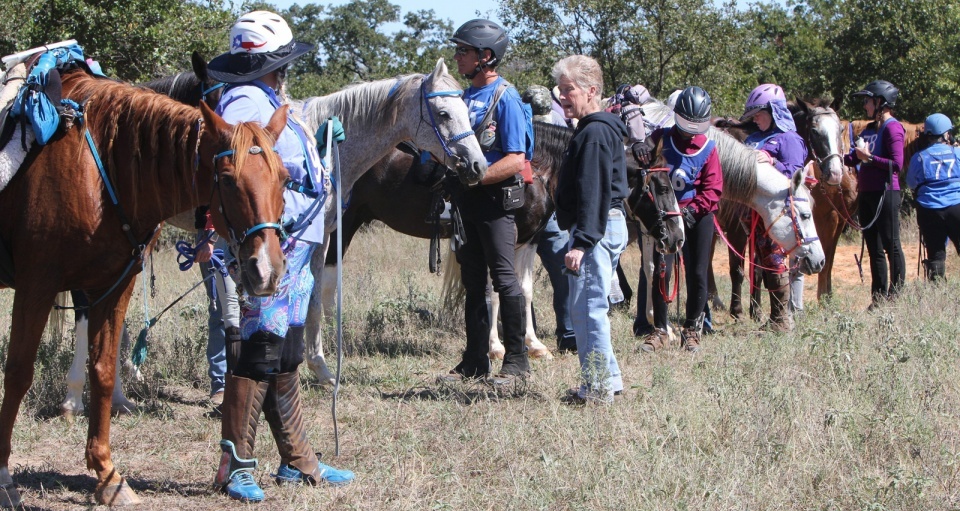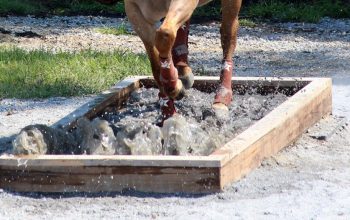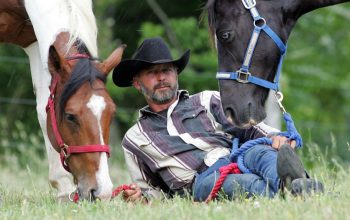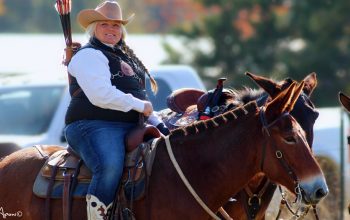
By Bev Roberts
Strategy in CTR. Really? You bet! While out on the trail, you will encounter many things. We have already talked about anxious horses and obstacles. This month we look at strategies for pulse and respiration checks (P&Rs).
NATRC uses P&Rs as a periodic measure of condition to aid both you and the veterinary judge to evaluate how your equine (horse, mule, donkey …) is doing over the course of the ride.
At a P&R, as riders arrive, they dismount and line their horses up side by side with about five feet between them. The P&R is a mandatory rest period in which riders take advantage of the time to help their mounts recover to normal parameters. As a minimum, you should loosen the cinch for three reasons: (1) to help cool the area near your horse’s heart, (2) to make your horse more comfortable, and (3) to make it easy for a P&R team member to place a stethoscope for taking your horse’s pulse. For safety, do not loosen the cinch so much that should your horse move suddenly the saddle would slip and dangle from your horse’s side or under her/his belly!
After 10 minutes from your arrival, a P&R team takes the horse’s pulse and respiration in a 15-second reading.

Readings higher than the normal maximums will cost your horse points. Use the ten minutes to cool and relax your horse. Riders use all kinds of strategies for this. What you decide to do depends on your horse, the temperature, the weather, the humidity, whether or not the P&R is in the sun or shade, the amount of breeze, and how hard your horse has been working.
A way to help you decide what to do is to take your horse’s pulse and respiration yourself when you first arrive after you loosen the cinch. Start with respiration. If it is in the high teens or more, you’ll have to work hard to cool her/him. If in the low teens, you’ll probably only have to fan her/him.
If the pulse is in the high teens, and doesn’t recover to near normal in 5 or 6 minutes and s/he is not hot, your horse may be hurting somewhere. Keep that in the back of your mind for being on the watch for pain, extreme fatigue, or lameness to develop, especially if s/he has not recovered to normal after 10 minutes.

The most effective cooling tactic for a hot, panting horse is to move her/him to shade, pull the saddle, dump gallons of cold water on your horse’s body, scrape off the water, fan your horse’s body and repeat. However, at most P&Rs, gallons of cold water are not available. So, if your horse is hot, pull the saddle, wet his neck with water you are carrying, scrape it off, and fan her/his whole body.
The second critical way to help is relaxation. So much of what you do depends upon how well you know your horse and what you’ve figured out works best for the two of you. Here is a list of strategies for you to try:
- Slowly rub the forehead or neck
- Scratch itchy spots and then do other strategies
- Talk or sing quietly to your horse
- Feed carrots, treats or electrolyte treats
- Cue for head lowing (teach this at home first)
- Squat by her/his head to encourage lowering even further
- Use reins or hands to flick away irritating flies
- Take a few big sighs to encourage your horse to do the same
- Stick your finger in the side of her/his mouth to encourage licking and chewing
- Leave her/him alone and do nothing but loosen the cinch

But wait! There are things you can do to avoid coming into a P&R “hot” in the first place.
- Know where you are on the trail in relation to where the P&R will be, and depending upon how hard your horse has been working, walk the last half to full mile into the P&R.
- The rules allow you to rest before doing a mandatory trot to a P&R. If your horse needs a rest, take it.
- Before a very steep or long ascent to a P&R, stop, check your horse and rest, if needed. Unless instructed to maintain forward motion on the ascent, stop along the way to let your horse catch her/his breath.
- Allow any anxious horses to go way ahead of you.
- Avoid having an anxious horse on your horse’s rump.
Everything you do at a ride is to achieve the goal of least stress and most enjoyment for you and your horse. Next month, more encounters on the trail!

This article is part VI of VIII parts. You can view previous parts of this series by following the links below:




